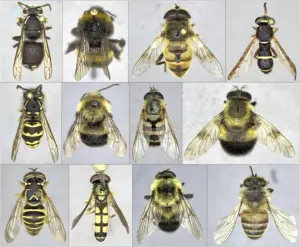 Background: Animals and plants can benefit by resembling other species. For example, some plants have spots that look like ants to deter herbivores, cuckoos look like hawks to frighten smaller birds from their nests, and harmless snakes have striped bodies that resemble highly venomous species. However, there are other modes of resemblance: animals and plants can smell, sound or act like another species in addition to (or instead of) having visual resemblance. However, we don’t know much about how different types of mimicry interact in the wild.
Background: Animals and plants can benefit by resembling other species. For example, some plants have spots that look like ants to deter herbivores, cuckoos look like hawks to frighten smaller birds from their nests, and harmless snakes have striped bodies that resemble highly venomous species. However, there are other modes of resemblance: animals and plants can smell, sound or act like another species in addition to (or instead of) having visual resemblance. However, we don’t know much about how different types of mimicry interact in the wild.
What we did: Heather Penney, a MSc student at Carleton University, collected individuals from 57 species of hoverfly. Hoverflies are famous for having some examples of very close visual mimicry of stinging wasps and bees, but in some species this mimicry is “imperfect”. It is also known that hoverflies can exhibit behaviours that are characteristic of wasps and bees, and so Heather tried to elicit these responses from each of the species that she caught. She found that only 6 out of 57 species exhibited behavioural mimicry, and that these species belonged to only two genera (i.e. they were all closely related). Furthermore, there was some evidence that only animals that looked a lot like wasps also had behavioural mimicry.
Importance: While behavioural mimicry has been described a number of times in the wild, it is rarely surveyed using such a comprehensive approach – Heather tested every species in a community so that we know that there are a range of species that do not exhibit these behaviours. Also, we show that the behaviours are constrained to relatively few high quality visual mimics which suggests that behavioural mimicry acts to enhance morphological mimicry where that morphological mimicry already exists.
This is part of a series of short lay summaries that describe the technical publications I have authored. This paper, entitled “The relationship between morphological and behavioral mimicry in hover flies (Diptera: Syrphidae)”, was published in the journal American Naturalist in 2014. You can find this paper on the publisher’s website or for free at Figshare.
Image credit: Photos by Brent Lamborn, used with permission.
